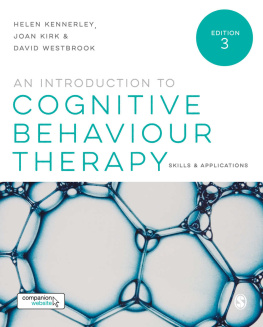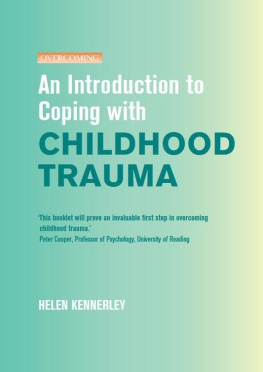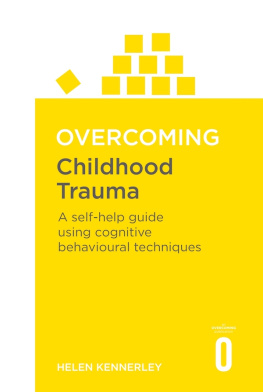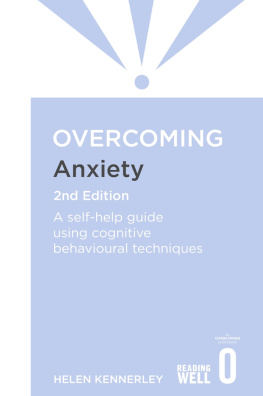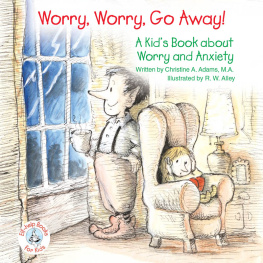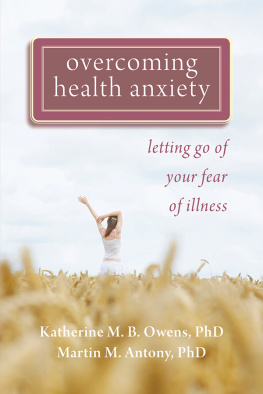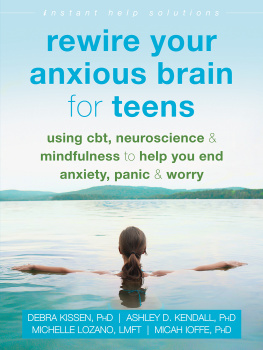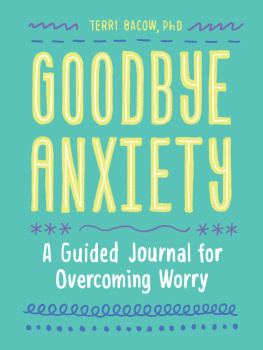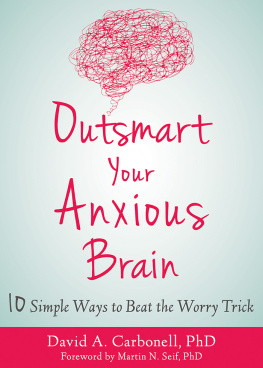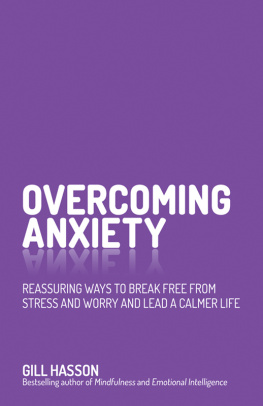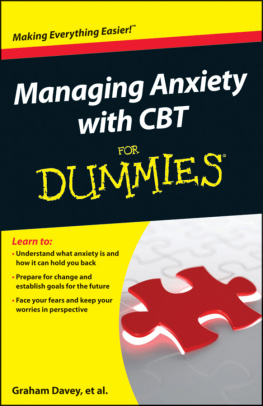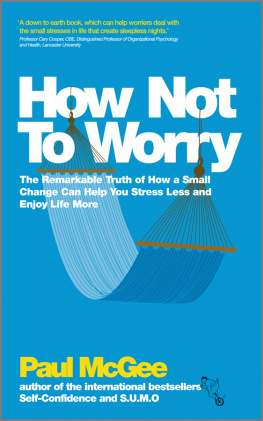Therapists can only write these sorts of books because of the insights that their patients give them and so Im grateful to those people Ive been fortunate enough to help over the years. Im also particularly grateful to Michele Kirsch, who has done her best to make this a more readable text, so that more of you might be able to benefit from it.
Fear, stress, worry and anxiety. These are all common terms for feelings that can cause problems and really interfere with our quality of life. This book will show you ways of managing them it will give you some basic coping skills. These skills are not a cure but ways to reduce the impact anxieties and fears have on your life. Although fear, stress, worry and anxiety are slightly different from each other, in this book the terms will be used as if they are similar and the strategies you will learn can help you get on top of them.
In order to get the most out of any self-help book, youll need to do more than just read through it youll need to do the exercises and practise the skills you learn. After all, if you bought a diet book but didnt follow the diet, you wouldnt lose weight. However, if you do read this book and follow the exercises you will gain a better understanding of your anxieties and you will learn some basic coping skills, which will help you reduce the problems they cause.
This self-help approach, based on the principles of Cognitive Behavioural Therapy (CBT), aims to put you back in control of your own thoughts, feelings and behaviour, so that you do not feel overwhelmed or restricted by worries and fears. You may be familiar with some of the techniques and you might even have tried them before. If they didnt work for you the first time, dont give up! It doesnt mean that you failed, or that the techniques are not right for you. Its possible you werent in the right frame of mind to fully engage in the work (and it is work), or perhaps you didnt give it enough time, or were too harsh on yourself. Interestingly, there is good evidence that not being harsh or unforgiving to yourself in the course of CBT practice will help it work for you.
HOW TO ADOPT A COMPASSIONATE ATTITUDE
In CBT, it has always been important to practise self-talk the conversation you have with yourselves in your head to encourage yourself to try out new ways of behaving and new ways of seeing things. It has become clear in recent years that the WAY you talk to yourself is also important. So if your inner voice is a bit of a bully, and you beat yourself up for not completing a task, or use negative language to spur yourself into doing something (Come on, you idiot, get on that plane right now or you will ruin everything and let the family down.), it is less likely that you will get the result you need. In order to make CBT really work, you have to be compassionate to yourself, and use gentle, encouraging language, as you would with someone you cared about. There will be plenty of examples of this in the book to help get a feel for the compassionate attitude, and you can read more about being compassionate in Professor Paul Gilberts book, The Compassionate Mind (see Useful Books and Resources at the end of this book).
So, if you find an exercise challenging or difficult, be gentle and encouraging to yourself no matter what the outcome. For example, if you have a fear of going to the cinema or a restaurant, a compassionate approach would be to recognize that this is difficult and to give yourself permission to build up to the challenge in small steps, perhaps taking along a supportive friend with you and certainly using the techniques you will learn in this book to manage your anxiety levels. If the outing is not a success, a compassionate approach would be to give yourself a pat on the back for trying, and then try again, or take a step back and try something else still challenging but less difficult. The non-compassionate approach would be to push yourself too far too soon and then criticize yourself for not meeting the challenge or, if you did meet the challenge, downgrading your achievements: That was no big deal, everyone can go to the cinema. Do you recognize any of these non-compassionate responses?
Its also important to remember that theres a big difference between self-compassion and opting for trying to avoid the problem youll need to get the balance right. Later in this book, well discuss avoidance in more detail so that youll be better at recognizing it. There will be times when youre just not able to face your fear and its OK to accept this when it happens, but overcoming your anxieties will mean eventually facing the uncomfortable feelings that arise when you try something new. Telling yourself, I wont go the cinema, or restaurant, because its just too difficult and Ill feel anxious, like I always do, is more akin to avoidance than compassion. But more about that later.
As you can see, your attitude towards yourself is important. In this book youll read about several ways in which anxieties can show themselves and the names given to these different types. These labels are helpful to an extent, but its crucial to not get hung up on them and VERY important not to think of yourself only in terms of your diagnosis. So, you are not a phobic, or an agoraphobic instead, you are a person who has problems with anxiety, or a person who has a phobia and, most importantly, a person who might also have a meaningful job, a family, a nice personality, a great sense of humour, and so on. Again, its about attitude. If you define yourself by your problem and youre not compassionate towards yourself, you limit your awareness of your strengths. You can also risk giving an unfair impression of yourself and others might make assumptions about you which are not true. Your anxiety is a part of you, but it is not you. With the help of this book you can begin to develop a more positive outlook and a better idea of who you are, so youll be able to be confident that you can do more of the things you want to do and be more the person that you want to be.
GETTING READY
Youve bought the book and youre ready to go its tempting to turn straight to the coping strategies and top tips for change. But your success will depend on good groundwork you need to be able to make the ideas in this book work for you, and that rests on you getting a good understanding of your difficulties so that you can make your coping plan personal. Therefore, the first half of this book goes into a lot of detail about anxieties, fears, worries and stress in order to help you pinpoint what drives your problems. When you have a good idea of this, you can build up the right coping plan for you which will be based on your sound understanding of your fears and worries. The second half of the book introduces you to a wide range of coping strategies that you can choose from. Youll learn about controlled breathing and how to relax to ease physical discomfort; thought management to tackle worrying thoughts; graded practice and problem-solving to help you face your fears; and youll learn how to cope in the long term how to make coping part of your life.
When you start to face your fears, youll do best if you have a familiar collection or range of coping methods. This means that youll need to practise the techniques in this book so that you know them well and have confidence in them. They also need to be well rehearsed enough for you to be able to call on them as you need to even in times of stress.
It is probably a good idea to first read the whole book through before starting your programme just to get familiar with anxiety disorders, the CBT approach and to get a sense of how it can help you. You can then work through the actual techniques in the book, taking one section at a time and trying to master one strategy before you move on to the next step. If you try something for a good while and find your anxiety levels are not coming down, dont worry, simply move on. You can always come back to the earlier section when youre ready. Not every technique will work for everyone, but do try each one so that you give yourself the best chance of developing the widest range of coping strategies possible for you. Its difficult to say just how long you should try any one method, but certainly daily practice for several weeks is a good idea. If youre still not getting results, you might need more time, or more external support from a friend or a professional such as your family doctor.


